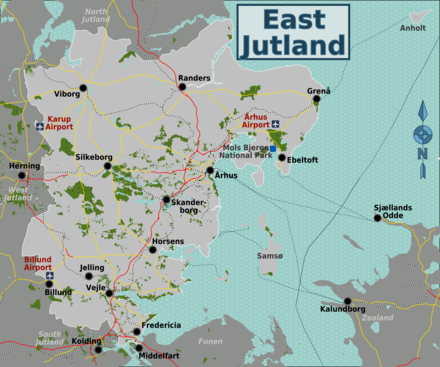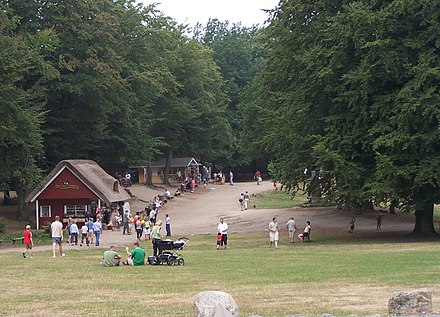East Jutland
East Jutland
East Jutland is the mid-eastern portion of Jutland, the mainland part of Denmark.
Cities

- Aarhus – harbour city and the largest city in Jutland
- Billund
- Bøgballe
- Ebeltoft – coastal town in Djursland (Jutland's "nose") with terminal for car ferries from Zealand
- Fredericia
- Grenå – coastal town in Djursland
- Horsens
- Jelling
- Randers
- Silkeborg
- Skanderborg
- Vejle
- Viborg
Other destinations
- Anholt
- Læsten Hills
- Mols Bjerge National Park – unique nature on Djursland
- Samsø – large beautiful island that gets all its energy from renewable sources
Understand
More than 60% of Denmark is cultivated land, making it the most intensely cultivated country in the world, and the East Jutland region is the largest agricultural producing area in the country. Apart from the obvious agricultural activities and legacy nearly everywhere in this region, including many large historic manors and estates, East Jutland surprisingly also presents sizable natural sites of both national and international importance.
Søhøjlandet (the lake-highlands) around Silkeborg is home to the largest single forest in Denmark (Silkeborgskovene) as well as the largest woodland area, the highest density of lakes and the highest hills in the country. With the maximum natural height above sealevel being just 176 metres, this doesn't say much really, but when the rest of the land is so flat, the hills do tend to present some magnificent vistas. The source of the two largest river systems in Denmark, Gudenå and Skjern Å is located in the heart of this region and the lakes associated with the Gudenå, dominates the landscape.
Djursland is the "nose" of the Jutland peninsula in the north-east. This is a rural area where the scarce population has made a living as farmers and fishermen for centuries, if not millenia. The region is rich with pre-historic tumuli, including many round barrows and several passage graves from the earliest of Stone Age. Djursland has a large diversity of habitats, with many rare or endangered species and most of the southern part has been designated as a national park since 2006, known as Mols Bjerge National Park.
Get in
Get around
See

- Himmelbjerget. Scenic view in beautiful area of lakes and hills. Get there from Silkeborg or Ry.
- Legoland in Billund - Famous amusement park, and one of countrys most popular attractions.
- Jelling national monument - Historic ruins from Denmark's prehistory.
- Djurs Sommerland - Large amusement park for the whole family. The largest roller coaster in Denmark.
- Ree Park - outdoor safari park with animals from all around the world. Take a round-trip in a steam locomotive or a landrover.
Do

- Gudenåen. Go on a canoe trip on the Gudenå river. See more on Silkeborg 2016-06-29

- Daubjerg Kalkgruber, Dybdalsvej, Daugbjerg, Viborg (Close to Viborg towards Holstebro on A16), 56.44261°, 9.14245°, +45 97548333, mail@daugbjerg-kalkgruber.dk. Jun: 10:00-16:00, Jul-Aug 15: 10:00-18:00, Aug 16-Oct: 11:00-16:00. Old limestone mines, museum of fossils. Explore the maze of tunnels where the infamous Jens Longknife lived 300 years ago DKK 70
- Mønsted Kalkgruber, 56.4546263°, 9.1695221°, +45 86646011. 10:00-17:00 Mar 20-Oct and week 7. Explore the largest limestone mine in the world DKK 70 2016-06-29
Eat
- Æbleflæsk (Apple-pork). Thick slices of fried pork belly with stewed apples. Traditional dish of the region.
Drink
Denmark has around 125 micro-breweries and the region of East Jutland is home to several:
- Aarhus Bryghus
- Wintercoat, near Aarhus.
- Bryghuset Kragelund, in Silkeborg.
- Ebeltoft Gårdbryggeri